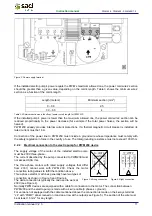
Instruction manual V 2.3
7
PWM 230 - PWM 400 - PWM 400/7.5
Instruction manual
CE EN 55014-1 (2001/11)
CEI EN 55014-2 (1998/10)
CE EN 61000-3-2 (2002/04)
CEI EN 61000-3-3 (1997/06)
CE EN 60335-1 (2004/04)
Basic Regulation: EN 61000-6-2 (2002/10)
Rif: CE EN 61000-4-2 (1996/09)
Rif: CE EN 61000-4-3 (2003/06)
Rif: CE EN 61000-4-4 (1996/09)
Rif: CE EN 61000-4-5 (1997/06)
Rif: CE EN 61000-4-6 (1997/11)
Rif: CE EN 61000-4-8 (1997-06)
Rif: CE EN 61000-4-11 (1997/06)
RESPONSIBILITY
The manufacturer is not liable for malfunctioning if the product has not correctly been installed, damaged,
modified, and/or run outside the recommended work range or in contrast with other indications given in this
manual.
The Manufacturer declines all responsibility for possible errors in this instructions manual, if due to misprints
or errors in copying.
The Manufacturer reserves the right to make any modifications to products that it may consider necessary or
useful, without affecting the essential characteristics.
The responsibility of the manufacturer is limited to the product and excludes costs or greater damages
caused by incorrect installations.
1 INTRODUCTION
The PWM system is installed downstream from a pump. Operation of the pump is regulated by the PWM so
that a constant water pressure is maintained. Moreover, depending on conditions and usage needs of the
hydraulic system, the pump is turned on or off and malfunction conditions are managed.
The end user sets the parameters using the keyboard, and the PWM manages the pump according to the
user’s needs (to do this, particular algorithms are used to control frequency of rotation). The PWM system
turns on the pump when there is a water demand and turns it off when there is no more demand of water.
PWM has many operation modes designed to protect the pump and the hydraulic and electric installations.
PWM has several configurable inputs and outputs and it can adapt to the demands of the various plants.
Section 5.1 describes all configurable quantities (pressure, protections, frequency of rotation, etc) and the
possible pressure regulation modes (as a function of flow, inputs, exchange with other PWM, etc).
An important feature that makes the difference between PWM and the common On/Off systems is the
considerable energy saving that can exceed 85% in some usage conditions. In Appendix an energetic and
economic comparison between direct-insertion and PWM systems is made.
The PWM allows a longer lifetime of the pump.
Noise emitted by the pump managed by a PWM system is generally much lower than that emitted by the
same one in direct insertion.
The model PWM 230 drives electro pumps with standard three-phase asynchronous motors (230V
configuration) even if a single-phase 230 V line supplies it.
The PWM 400 and PWM 400/7.5 models drive electro pumps with standard three-phase asynchronous
motors (400V) and a three-phase line supplies them.
Note:
This manual is related to the following products: PWM 230, PWM 400 and PWM 400/7.5; for simplicity
sake the term “PWM” will be used when talking about characteristics that are common to all the versions.
Otherwise the specific names of the products will be used.
RoHS
















































